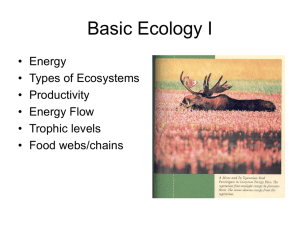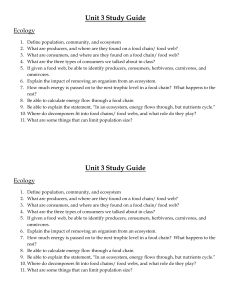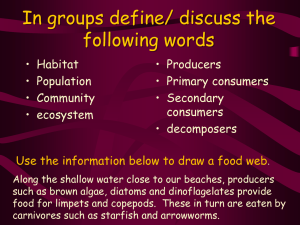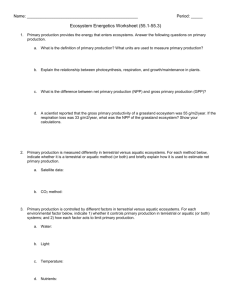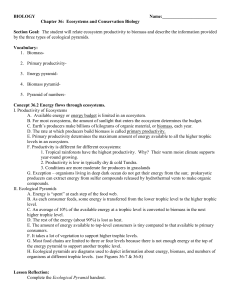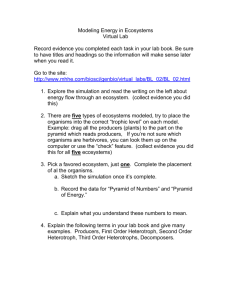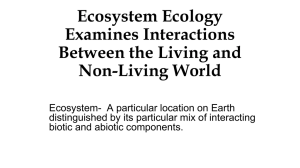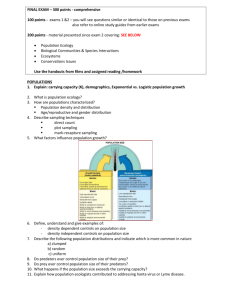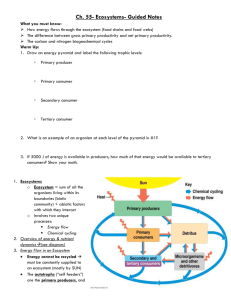Supplementary Notes (PJ Shlachtman, Miller book) Ecology
advertisement
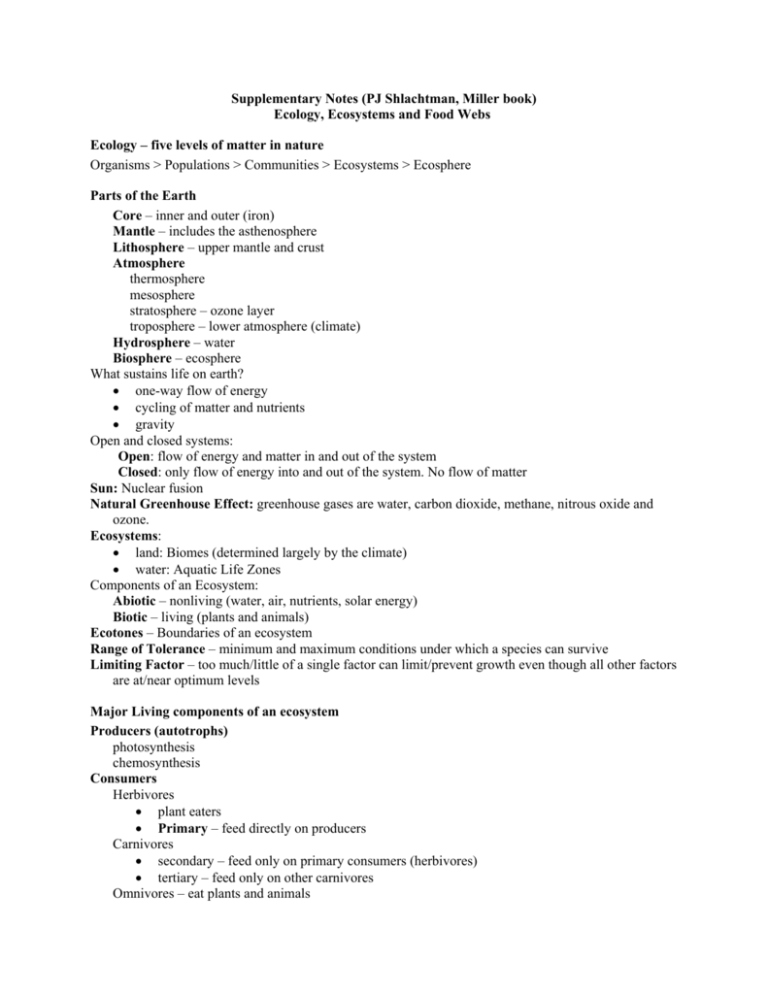
Supplementary Notes (PJ Shlachtman, Miller book) Ecology, Ecosystems and Food Webs Ecology – five levels of matter in nature Organisms > Populations > Communities > Ecosystems > Ecosphere Parts of the Earth Core – inner and outer (iron) Mantle – includes the asthenosphere Lithosphere – upper mantle and crust Atmosphere thermosphere mesosphere stratosphere – ozone layer troposphere – lower atmosphere (climate) Hydrosphere – water Biosphere – ecosphere What sustains life on earth? • one-way flow of energy • cycling of matter and nutrients • gravity Open and closed systems: Open: flow of energy and matter in and out of the system Closed: only flow of energy into and out of the system. No flow of matter Sun: Nuclear fusion Natural Greenhouse Effect: greenhouse gases are water, carbon dioxide, methane, nitrous oxide and ozone. Ecosystems: • land: Biomes (determined largely by the climate) • water: Aquatic Life Zones Components of an Ecosystem: Abiotic – nonliving (water, air, nutrients, solar energy) Biotic – living (plants and animals) Ecotones – Boundaries of an ecosystem Range of Tolerance – minimum and maximum conditions under which a species can survive Limiting Factor – too much/little of a single factor can limit/prevent growth even though all other factors are at/near optimum levels Major Living components of an ecosystem Producers (autotrophs) photosynthesis chemosynthesis Consumers Herbivores • plant eaters • Primary – feed directly on producers Carnivores • secondary – feed only on primary consumers (herbivores) • tertiary – feed only on other carnivores Omnivores – eat plants and animals Other consumers • scavengers • Detritivores • Decomposers Respiration Aerobic Anaerobic Food Webs and Energy Flow in Ecosystems Food Chain: • high quality energy (sunlight) is converted to nutrients by photosynthesis • This energy is passed on to consumers and eventually decomposers. • Low quality heat is emitted into the environment Trophic Level: feeding level producers 1st trophic level primary consumers 2nd trophic level secondary consumers 3rd trophic level etc. Food Web is an interconnected food chains (complex) 1. grazing food webs 2. detrital food webs Biomass Ecological Efficiency • the percentage of energy transferred from one trophic level to another. • a 10% efficiency means that 90% of the energy is lost. Pyramids of Energy Flow • illustrate energy loss in a food chain • help explain how the Earth can support more people if people would eat more grains, vegetables, etc., and not eat consumers of those grains (steer, deer, etc.) • Top level carnivores (eagles, hawks, tigers, sharks) o few in number and are the first to suffer when the ecosystems are disrupted. o thus especially vulnerable to extinction. Storage of biomass at various trophic levels can be represented by a pyramid of biomass. Pyramid of Numbers Gross Primary Productivity (GPP) – the rate at which an ecosystem's producers convert solar energy into chemical energy as biomass Net Primary Productivity (NPP) – biomass that is left after producers use some for their own use. How do Ecologists learn about Ecosystems? Field Research – go out and see/measure what’s going on in nature Lab Research – observe/model parts of nature under controlled conditions Systems Analysis – simulates ecosystems to study structure and function Systems Measurement –Define objectives; identify and inventory variables; obtain baseline data on variables Data Analysis – Make statistical analysis of relationships among variables; determine significant interactions Systems Modeling – construct mathematical models describing interactions among variables Systems Simulation –run the model on a computer to evaluate different values for variables Systems Optimization – evaluates best ways to achieve objectives Ecosystem Services and Sustainability Why is Biodiversity such an important ecosystem service? The two Basic Principles of Ecosystem Sustainability 1. nature uses renewable solar energy as energy source 2. nature recycles relatively efficiently.
